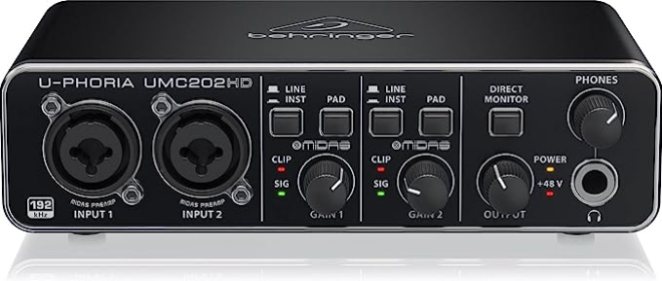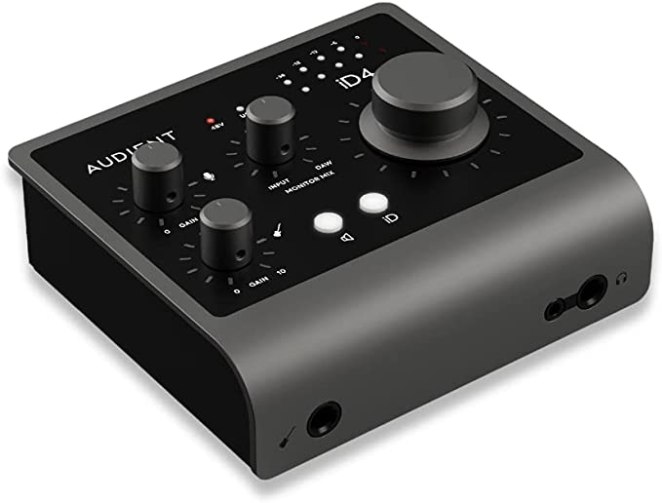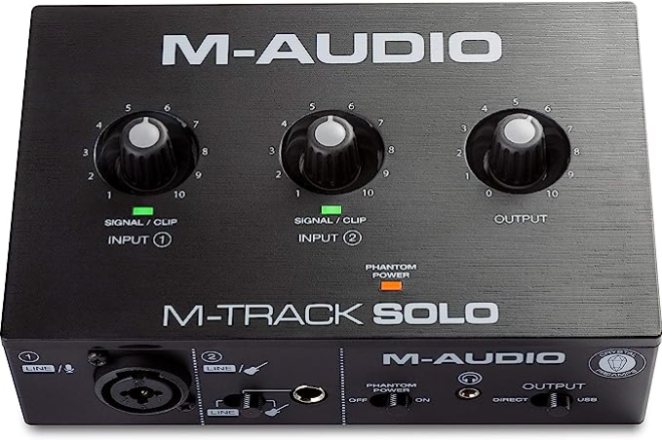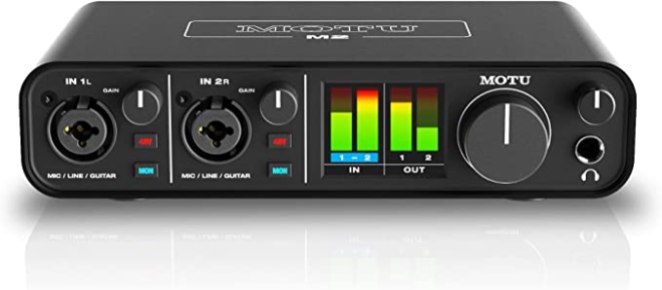When you buy through our links, we may earn an affiliate commission.
I recently wrote an article on what I believe are the best audio interfaces in the market for those looking to upgrade their existing gear or experiment with music production for the first time.
For a music producer, choosing the right one is a crucial step that’ll define their workflow and creativity, so doing proper research becomes even more vital when we have a tight budget but still want to make music that sounds professional.
Luckily, there are plenty of options for artists on a budget looking for the best audio interfaces, and today we'll look into the ones that offer the best value for money.
All around $200, the best budget options will help you bring the sound of your dreams to life and open up all sorts of opportunities to unleash your creativity.
And while I firmly believe the best budget choice is the Focusrite Scarlett 2i2, there are plenty of high-quality, budget-friendly interfaces in the market right now, so let's take a look at all of them so you can make an informed decision on what's the right one for your needs.
Quick Summary Of Our Top Choices
- Focusrite Scarlett 2i2 (Best Overall)
- Behringer U-PHORIA UMC202HD (Best Runner-up)
- Audient iD4 Mk2 (Best With USB 3.0)
- M-Audio M-Track Solo (Cheapest)
- Presonus Studio 24c (Best Software Bundle)
- Native Instruments Komplete Audio 6 (Best for Bands)
- Arturia MiniFuse 2 (Best for Electronic Producers)
- MOTU M2 (Best for Streamers and Podcasters)
Best Budget Audio Interfaces
When compiling this list, I focused on interfaces that deliver professional results despite their entry-level price tag, designed by worldwide-known brands or new companies that impressed me with their attention to detail.
Aside from audio quality, I paid attention to compatibility, connectivity options, the number of inputs and outputs, and build quality.
All these factors are crucial when buying an interface on a budget, so below you'll find a review of each item where all these aspects are considered, and at the end of the article, an in-depth buyer's guide where I'll tackle all these topics.
1. Best Overall – Focusrite Scarlett 2i2

SPECS
- Connectivity: USB 2.0
- Resolution: 24-bit/192kHz
- Input/Output: 2x2
- Midi: NO
Now in its third generation, the Focusrite Scarlett 2i2 is a must-have for new music producers who want to get professional sound quality from day one.
For years, Focusrite has been a household name in the world of music production, and the iconic Scarlett 2i2 is an item you'll find in recording studios large and small across the globe.
The interface comes with exceptional preamps that naturally reduce distortion and noise and the popular and switchable Air mode that'll add presence and openness to your music.
With two inputs, the Focusrite Scarlett 2i2 will allow you to record and playback two channels independently.
The Focusrite Scarlett 2i2 is an affordable yet professional device that’ll help you bring to life high-quality music. I highly recommend it because it’s easy to use and comes with a plethora of virtual tools to craft your sound signature.
2. Best Runner-up – Behringer U-PHORIA UMC202HD

SPECS
- Connectivity: USB 2.0
- Resolution: 24-bit/192kHz
- Input/Output: 2x2
- Midi: NO
I’m a huge fan of the Behringer U-PHORIA series because it delivers accurate and pristine audio recordings without breaking the bank, with a solid build quality that allows you to carry the interface around without issues.
One of the most interesting features of the UMC202HD is undoubtedly its zero-latency, direct monitoring feature, meaning you can monitor the instruments you're recording in real time and without delay.
Other great aspects of this powerful choice include the two balanced TRS outputs for multiple monitoring options, two high-quality MIDAS preamps, and the +48V phantom power.
Behringer has decades of experience in the world of music production, and the U-PHORIA UMC202HD is the embodiment of the dedication and attention to detail you can see in all their products. See our full review of the Behringer U-PHORIA UMC202HD to learn more.
3. Best With USB 3.0 – Audient iD4 Mk2

SPECS
- Connectivity: USB 3.0
- Resolution: 24-bit/96kHz
- Input/Output: 2x2
- Midi: NO
Don’t let the size of this tiny product fool you: the Audient iD4 Mk2 is a phenomenal device packed with features that can help you create unforgettable hits.
The USB 3.0 speed reduces latency significantly, making it easier to record more instruments simultaneously.
The high-quality, transparent converters provide 120dB of dynamic range, and the analog JFET DI effect will enhance the sound quality of your guitar, piano, or bass by enriching it with natural harmonics.
If that’s not enough, the Audient iD4 Mk2 comes with the impressive ARC software suite, including Steinberg’s Cubase DAW, free music courses from Produce Like a Pro, cab simulators, and VST plugins.
If you're specifically looking for the best guitar audio interfaces, we've got you covered. Check out our comprehensive guide on the top picks in the market today.
4. Cheapest – M-Audio M-Track Solo

SPECS
- Connectivity: USB 2.0
- Resolution: 16-bit/48kHz
- Input/Output: 2x2
- Midi: NO
The M-Audio M-Track Solo makes music production affordable for anyone. At around $50, this powerful interface offers interesting features such as phantom power, a Crystal preamplifier, and a single XLR/TRS combo input that ensures you can record your instruments easily and professionally.
The direct Monitor option enables you to listen to your recordings in real time without delay, and the rich software bundle, including the MPC Beats DAW and 20 plugins from Avid, will give you enough tools to get you started and then some more.
The unbeatable price, portability, and performance make the M-Audio M-Track Solo a valid, budget audio interface for artists in all career levels.
5. Best Software Bundle – Presonus Studio 24c

SPECS
- Connectivity: USB
- Resolution: 24-bit/192kHz
- Input/Output: 2/2
- Midi: YES
I've been using Presonus products for decades, from their Eris studio monitors to the exceptional Studio One DAW, and you can't help but appreciate the attention to detail, quality, and affordability that characterizes their vast product range.
The Presonus Studio 24c is no exception. This straightforward audio interface is the ideal solution for producers using MIDI instruments such as keyboards and pads, as it comes with a 5-pin MIDI I/O port and a software package that'll leave you speechless.
The XMAX-L preamps deliver a warm, natural sound that'll enhance the characteristics of your musical instruments, and with Studio One Artist and Studio Magic plugin suite, you'll have everything you need to refine your sound and create timeless tracks.
6. Best for Bands – Native Instruments Komplete Audio 6

SPECS
- Connectivity: USB 2.0
- Resolution: 24-bit/192kHz
- Input/Output: 6 x 6 (4 analog + 2 digital)
- Midi: YES
The most expensive device on this list, the Native Instruments Komplete Audio 6, is an all-in-one solution that’ll upgrade your recording studio and unleash your creativity.
It offers plenty of inputs and outputs, a rich software bundle, and a high-quality sound that can compete with big-budget music productions.
The four analog inputs (two XLR/TRS combo inputs and two line/instrument inputs) and the MIDI connectivity ensure artists can make the most of their gear and record multiple instruments simultaneously.
Furthermore, zero-latency direct monitoring allows for recording instruments and vocals with absolute accuracy.
Komplete Audio 6 comes with Native Instruments' iconic instrument effects and Maschine Essentials, among others, which will help you create your signature sound or further expand your sonic palette.
At $250, the features offered by the Native Instruments Komplete Audio 6 are truly a bargain.
Read the full Native Instruments Komplete Audio review to learn more.
7. Best for Electronic Producers – Arturia MiniFuse 2

SPECS
- Connectivity: USB 2.0
- Resolution: 24-bit/192kHz
- Input/Output: 2x2
- Midi: YES
Another fantastic option for home producers is the MiniFuse 2 by Arturia, a brand that’s become synonymous with high-quality MIDI keyboards and phenomenal sound effects.
The MiniFuse 2 comes packed with exciting features, most notably the MIDI connection, the zero-latency monitoring option, and the virtual stereo loopback channel to record audio from your computer while also using the two analog inputs.
A solid build quality, rich bundled software, and the renowned Arturia FX included make the MiniFuse 2 a music powerhouse for the versatile artist who wants a vast sonic library and a highly-performant interface. If you'd like to learn more, check out our full detailed review of the Arturia MiniFuse 2.
8. Best for Streamers and Podcasters – MOTU M2

SPECS
- Connectivity: USB 2.0
- Resolution: 24-bit/192kHz
- Input/Output: 2x2
- Midi: YES
Versatile and intuitive, the MOTU M2 has quickly become one of the most beloved interfaces for beginners.
Thanks to cutting-edge DAC technology and exceptionally low latency, this portable choice performs magnificently both on the road and in the studio, bringing to life pristine audio that you can refine with the rich bundled software included.
A great feature is the built-in loopback functionality, allowing you to record multiple analog recordings with the computer playback: a crucial factor for streamers and podcasters who can combine real-time recordings with pre-recorded sounds and effects.
The Full-color LCD screen can show you the interface's parameters in real time, while the professional preamps and phantom powers enable you to make the most of your recording gear.
Finally, the MOTU M2 comes with the MOTU Performer Lite and Ableton Live 10 Lite DAWs and 6GB of free loops and samples to get you started.
Buyer's Guide | What You Need to Know
Now that we have covered the best budget-friendly audio interfaces, it's time to look into what defines a good from a bad one and how you can identify which one will best suit your needs.
Although budget plays a crucial role here, you shouldn't be guided exclusively by the price tag when shopping for your creative purposes.
Here are the features to pay attention to when buying on a budget.
Connectivity
When exploring the world of affordable audio interfaces, you’ll find different connectivity types, namely USB, Thunderbolt, PCIe, and FireWire.
USB is undoubtedly the most popular one and will guarantee compatibility with most gear and high-quality sound. The latency (which we'll discuss later) largely depends on the type of USB connectivity provided: USB C, USB-2, or USB-3.
Thunderbolt is an excellent connectivity option that can transfer data way faster than a standard USB, but budget choices generally don’t offer this type of connectivity.
However, should you wish to upgrade your gear in the future, you might be pleased to hear that Thunderbolt is seamlessly cross-compatible with USB, so you can use Thunderbolt interfaces so long as you have a laptop with a USB port.
If you're looking for the lowest possible latency and budget is not an issue, PCIe is the best option. It requires integrating your interface directly into the computer's motherboard, and the installation process is way more demanding, but the results are exceptional.
FireWire connectivity was popular until a decade ago before being largely replaced by USB connections.
Nowadays, it's hard to find a computer with a built-in FireWire port; still, FireWire interfaces have low latency and sound good, so if by any chance you come across one and have the right gear to make it work, I'd suggest you give it a try.
Input/Headphone Output (I/O) Channels
Choosing the correct number of inputs and outputs will have a crucial impact on your workflow, so my recommendation is to think carefully about what you need when recording music.
If you're a so-called bedroom producer, one input might be enough (for a while at least) since you'll be recording each instrument separately and then combining them in your DAW.
However, getting an audio interface with a single input might limit your options in the long run, preventing you from experimenting with multiple recording inputs simultaneously.
If you’re a singer/songwriter, you should have an audio interface with at least a couple of inputs: for instance, even if you record your vocals and guitar separately, you’ll still need a couple of mics to capture the sound of your guitar professionally.
If you’re recording bands, live performances, or even just drums, you’ll need an audio interface with four or more inputs. Once again, it all comes down to what you’ll be recording, and every “real” musical instrument comes with a standard procedure to get professional recordings.
My advice is to consider the use you'll make of your audio interface in the long run and then choose accordingly. It might be worth investing a bit more than having to upgrade your gear after a few months.
Portability
You might be traveling extensively with your recording devices. If you’re a touring artist, chances are you’ll take your equipment on the road, so you need professional tools that you can carry with you at all times.
If that's the case, you also might want to consider battery-powered choices: an excellent solution for musicians on the road or even field recording artists who can't always rely on electricity.
If portability is vital, I'd recommend a couple of interfaces: M-Audio M-Track Solo for the touring artist and the IK Multimedia iRig Pro Duo as the best battery-powered option.
Bundles
Interfaces come with bundled software that can help save a lot of money and avoid looking for compatible DAWs and plugins. In particular, budget interfaces often come with everything an artist needs to record and mix their music professionally.
When studying the bundle offered, look for DAWs and VST plugins that are in line with your music genre, and opt for ones that provide full, unlimited access: in this way, you'll be able to use those tools indefinitely, and will become part of your sonic palette.
Latency and Buffer Size
Latency and buffer size must be considered because they define the performance and processing power required to record audio professionally.
Latency is the delay between an audio signal entering the audio interface and the sound being played back. Lower latency is preferable, especially when precise timing is essential (recording multiple instruments simultaneously).
Buffer size is the amount of audio data stored in the interface's buffer before it's processed and sent to the output, and it is measured in samples: 64, 128, 256, and so on. A lower buffer size means lower latency but higher CPU stress, and vice versa.
All in all, you should look for a cheap option that'll work well with your computer without putting too much stress on your CPU.
All the audio interfaces mentioned in this article are not too CPU-demanding, so they should work well on your device, so long as it's not too old or extremely cheap.
Frequently Asked Questions (FAQs)
What is an audio interface?
An audio interface is a device that bridges the gap between your analog audio sources (musical instruments, microphones, and mixers) and your digital audio workstation (DAW) on your computer. It’s a crucial tool in modern music production.
Most audio interfaces feature a digital-to-analog converter (DAC), a preamp, and an analog-to-digital converter (ADC) to convert an analog signal to digital.
Why do I need an audio interface?
Audio interfaces are the best way to get high-quality audio recordings without entering a recording studio.
Generally, computers' built-in soundcards cannot deliver professional results in terms of audio quality and latency; that's why most music producers rely on audio interfaces to create their tracks.
All in all, this device offers better sound quality, low latency, and multiple inputs and outputs to record more than one instrument at once. Some options also have phantom power, MIDI connectivity, and headphone amplification.
How many inputs and outputs do I need?
The number of inputs and outputs required depends on your creative workflow. Podcasters or solo artists might do just fine with one input, whereas bands should look into audio interfaces with at least four inputs.
Headphone output channels are also useful for mixing and mastering music, giving you multiple options to listen to and analyze your music.
What is phantom power, and do I need it?
Phantom power provides the necessary electrical power to condenser microphones so that they can operate.
Condenser microphones require phantom power to function, as they use it to energize the microphone's internal electronics, so if you use this type of mic, you'll need an audio interface with phantom power (which nearly every one has, by the way).
How do I troubleshoot common issues with audio interfaces?
Check the connections, ensuring that everything is connected correctly using the appropriate cables. Next, check the audio settings of the audio interface, the DAW, and the computer, to see if they're all aligned.
Restart the computer, interface, and DAW, and see if everything works now. If all else fails, test the interface with another computer to see if the problem lies in your computer.
What to look for when buying an audio interface?
In short, you should look for USB audio interfaces that allow you to record your instruments professionally.
Whether you use condenser mics, dynamic mics, or virtual instruments, you'll be able to find a great budget audio interface to meet your expectations.
Other factors to take into account are multiple output options to make the most of your monitor outputs and headphones. If you travel often, look for a compact choice with professional recording software included.
Finally, the bundled software. Look for a budget interface that comes with valuable plugins and DAWs: having professional recording software and dozens of effects from day one will help you create a unique signature right away.
Final Thoughts
To summarize, I'd recommend the Focusrite Scarlett 2i2 to anyone entering the world of music production: it's easy to use, performs magnificently, and can last a lifetime.
Alternatively, I'd opt for the Presonus Studio 24c: a great and affordable interface that comes with a rich bundle of professional VST plugins and the amazing Studio One.
Upgrade without overspending! Dive into the best budget DAC options and transform your audio experience on a budget.
Have fun!
